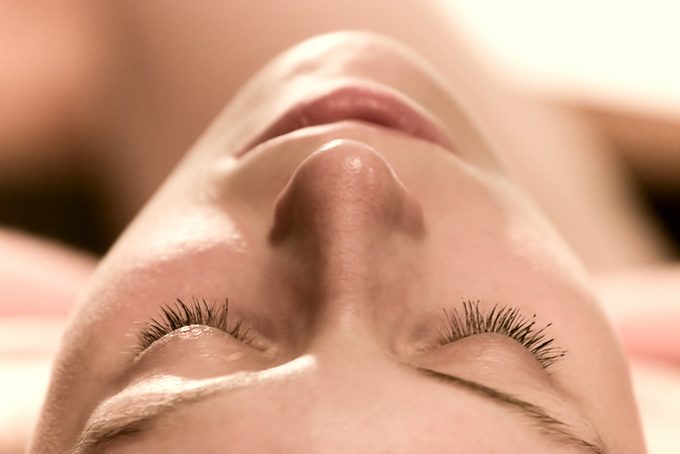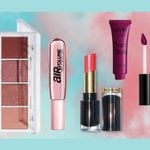Is Eyelash Tinting Safe?
Beauty expert Rhonda Rovan answers your questions about whether or not eyelash tinting is a safe beauty treatment.

My eyelashes are invisible without mascara. Is eyelash tinting safe?
I have insight from first-hand experience: I get my blonde eyelashes dyed a few times a year. It’s a routine beauty treatment for me in summer when I’m in and out of the water. Tinting gives the eyes definition and lets you go without mascara, at least for a few weeks until eyelashes fall out and are replaced by new ones (this happens naturally whether they’re tinted or not).
However, I’ve uncovered some information that has given me pause.
What’s the procedure?
Eyelash tinting, done in salons and spas by an esthetician. Clients choose from brown, black or the more dramatic blue-black (that’s the one I get; it’s a very dark black). If you’re a contact lens wearer, you remove them. You sit, wearing a protective towel on the neck so the dye doesn’t get on your clothing. The esthetician applies a protective cream, such as Vaseline, under the eyes, which prevents the skin from getting stained. Then a thin cotton pad shaped in a curve goes on top of the cream. You shut your eyes, and the tint is applied to lashes with a fine brush, and allowed to set for at least 10 minutes.
With your eyes still shut, the esthetician begins to remove the dye with a cotton pad dampened with water. This might take a few minutes of gentle strokes and several pads. When the excess dye has been removed, you open your eyes; the esthetician cleans up the under-eye area and the lid with additional dampened pads, if there is staining. (Thinking of getting eyelash extensions instead? Here’s what you should know beforehand.)
What are the dyes made of?
I called several salons across Canada, and they all use a brand of dye from Austria called RefectoCil (although it is not the only brand available here). “I’d often heard eyelash tints are vegetable dyes, but that is a marketing legend,” says Michael Ferro, head of sales brands for GW Cosmetics, the manufacturer of RefectoCil, whom I reached in Leopoldsdorf, Austria. Ferro says RefectoCil has a coal tar base. “Estheticians mix the colour paste with a peroxide solution to start the chemical process.” The peroxide is what makes the molecules chain to the hair.
Is there such a thing as vegetable-based eyelash tint?
I couldn’t find evidence of it. Lynn Shulman, owner of Elixir Organic Spa in Toronto, which uses only natural and organic products, says: “I get calls all the time from people looking for natural-formula eyelash tinting. But it doesn’t exist. If a dye is going to deposit colour, it will have chemicals.” I did find one that bills itself as fruit-based; the product, from Spain, is called Thuyla. However, the Canadian distributor was frank: It’s not all-natural.
In the U.S., RefectoCil and other coal tar-based eyelash and eyebrow tints are banned by the Food and Drug Administration (FDA). (Despite that, I was able to find some salons south of the border that use it, after making just a few phone calls.) Health Canada lists coal tar dye in eye products on its Cosmetics Ingredient Hotlist of substances restricted — or prohibited in cosmetics. However, Gary Holub, a Health Canada spokesperson, says today’s coal tars are synthetic and have a high level of quality and purity, as they undergo a refining process to remove any unacceptable impurities.
Now, Health Canada notes that in Europe coal tar dyes are permitted and used by professionals for eyebrow/eyelash colouring, with few injury reports. In April 2010, it issued a notice saying it considers application of coal tar dyes to areas around the eye by a professional to pose a low health risk, and it is developing industry guidance to promote the safe professional application of these products.
How do you know your esthetician has the proper training?
Edmonton-based Crystal Armstrong, a board member for quality assurance for Leading Spas of Canada, and spa director of Phoenix Renewal Centre & Spa, says, “There is no one standard across esthetician schools, nor one across provinces. One Alberta esthetician told me that in her school, tinting was a smaller training module than facials. It’s 10 applications versus 20 to 25 for facials.”
Ferro says allergic reactions can be avoided by doing a patch test on the forearm or behind the ear 24 to 48 hours before the treatment.
From time to time, I feel a bit of burning in my eyes when I get my lashes tinted. Ferro says this is from the 3 percent peroxide. If the colour paste gets in the eyes, we recommend flushing with cold water. My esthetician rests a cold cotton pad on my eye, and the pain disappears.
But eye surgeon Dr. François Codère, president of the Canadian Ophthalmological Society, and an associate professor in the departments of ophthalmology at McGill University and the University of Montreal, says eyelash tinting should be avoided. “Anything designed to tint strands of hair is potentially dangerous around the eyes. Most people might not have a problem, but when they do, it could be serious — like severe inflammation and swelling. There could also be risk of allergy to the skin of the lid. And if the chemical content comes in contact with the eye, it can damage the delicate cornea.”
Codère, who has never had anyone come see him because of a problem due to eyelash tinting, says you should see a doctor if you experience swelling, redness, pain and change in vision.
The bottom line on eyelash tinting
Health Canada has had two consumer complaints regarding eyelash dyes, both involving an allergic reaction. If you do have an adverse reaction to an eyelash/eyebrow dye (or to any cosmetic), you can submit a complaint via the Consumer Product Incident Report Form.
Deciding whether to tint your eyelashes is obviously a personal choice. Before you put yourself in an esthetician’s hands, find out what training and experience she has. As for me, I’ll continue to tint. I’m confident about my esthetician, whom I’ve been going to for many years, and whom I consider qualified to do this service. I go with my gut on this one. Next, read up on the 10 biggest 2019 beauty trends.




